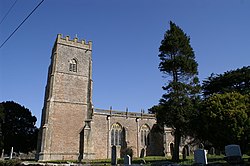Rodney Stoke
| Rodney Stoke | |
| Somerset | |
|---|---|
 Church of St Leonard, Rodney Stoke | |
| Location | |
| Grid reference: | ST486501 |
| Location: | 51°14’51"N, 2°44’9"W |
| Data | |
| Population: | 1,260 (2001) |
| Post town: | Cheddar |
| Postcode: | BS27 |
| Dialling code: | 01749 |
| Local Government | |
| Council: | Mendip |
| Parliamentary constituency: |
Wells |
Rodney Stoke is a small village in Somerset, 5 miles north-west of the City of Wells. The village is on the A371 between Draycott and Westbury-sub-Mendip.
The parish is situated within an area of high biodiversity supporting local rare species of plants and animal life. It is part of the Winterstoke Hundred.[1]
The cross roads may be the site of an old Roman road.[2]
This is one of the nine Thankful Villages in Somerset which suffered no fatalities during First World War. There is a memorial window in the Parish Church together with a new plaque that testifies to the village's enduring thankfulness to God for their good fortune.
History
Close to the village is Westbury Camp, which represents the remains of an Iron Age enclosed settlement[3][4] and has been designated as a Scheduled Ancient Monument.[3][5]
Rodney Stoke was listed in the Domesday Book of 1086 as Stoches, meaning 'a stockaded place' from the Old English stoc; a common place-name. In 1291 the name was recorded as Stokgifford.
The Giffords were English nobility at the time of Edward the Confessor with Walter Gifford (then spelt Gifard) as the Earl of Buckingham.[6]
The village was the home of, and is probably named after, Sir John Rodney (c1561–1612). However Ekwall [7] indicates that Stoke Gifford was held by Richard de Rodene in 1303.
The first Baron Rodney was George Brydges Rodney (1718/19–92), an admiral of the Royal navy during the Napoleonic Wars.[8]
Church
The parish church is St Leonard. It was built around 1175 and is a Grade I listed building.[9] The interior of the church contains a screen, bearing the date 1624, the gift of Sir E Rodney,[10] which includes a representation of the martyrdom of St Erasmus, who was killed by having his entrails removed.[8]
Wildlife
The land is noteworthy for its importance as a flight corridor and feeding ground for the Greater Horseshoe Bat. The Cheddar Complex, a Site of Special Scientific Interest, lies to the north and Mascalls’ Wood, an ancient woodland and Somerset Wildlife Trust Nature Reserve, lies to the west.
Close to the village is the Rodney Stoke nature reserve, which is also designated a Site of Special Scientific Interest.
Outside links
| ("Wikimedia Commons" has material about Rodney Stoke) |
References
- ↑ "Somerset Hundreds". GENUKI. http://www.genuki.org.uk/big/eng/SOM/Miscellaneous/. Retrieved 9 September 2011.
- ↑ "Extensive Cropmarks, SW of Cheddar". Somerset Historic Environment Record. Somerset County Council. http://webapp1.somerset.gov.uk/her/details.asp?prn=11224. Retrieved 6 November 2007.
- ↑ 3.0 3.1 Firth, Hannah (2007). Mendip from the air. Taunton: Somerset County Council. ISBN 978-0-86183-390-0.
- ↑ "Walton Castle". Fortified England. http://www.fortifiedengland.com/Home/Categories/ViewItem/tabid/61/Default.aspx?IID=1534. Retrieved 16 January 2011.
- ↑ "Westbury Camp hillfort, N of Stoke Woods, Rodney Stoke". Somerset Historic Environment Record. Somerset County Council A. http://webapp1.somerset.gov.uk/her/details.asp?prn=24269. Retrieved 16 January 2011.
- ↑ Robinson, Stephen (1992). Somerset Place Names. Wimborne, Dorset: The Dovecote Press Ltd. ISBN 1-874336-03-2.
- ↑ Ekwall, Eilert (1959). The Concise Oxford Dictionary of Place-Names, 4th Edition. London: Oxford University Press.
- ↑ 8.0 8.1 Reid, Robert Douglas (1979). Some buildings of Mendip. The Mendip Society. ISBN 0-905459-16-4.
- ↑ National Heritage List 1058592: Church of St Leonard
- ↑ Church of St Leonard – HEVAC Heritage
